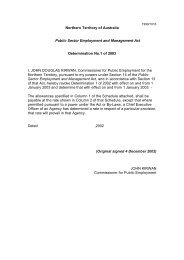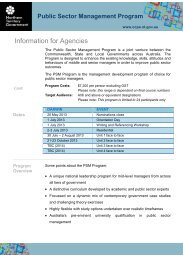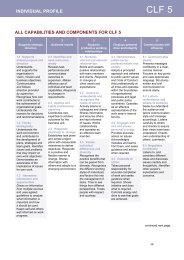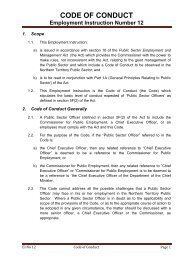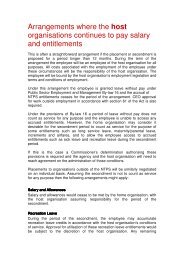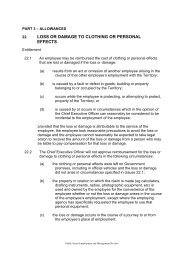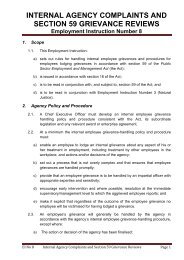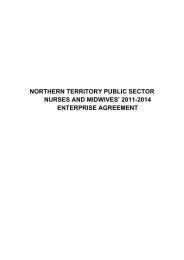Making Workforce Planning Work in the NT Public Sector
Making Workforce Planning Work in the NT Public Sector
Making Workforce Planning Work in the NT Public Sector
Create successful ePaper yourself
Turn your PDF publications into a flip-book with our unique Google optimized e-Paper software.
How do you doworkforce plann<strong>in</strong>g– gett<strong>in</strong>g startedTip:• You need to start with whatyou have now – <strong>the</strong>n buildon <strong>the</strong> data over time asyou ref<strong>in</strong>e <strong>the</strong> process andbuild workforce plann<strong>in</strong>gcapabilities <strong>in</strong> your agency.If <strong>the</strong> agency executive has clearly demonstrated strategic leadership andgovernance <strong>in</strong> workforce plann<strong>in</strong>g and you are a part of <strong>the</strong> team of ‘champions’identified to implement workforce plann<strong>in</strong>g, you can be confident to proceed.If, however, you have been delegated responsibility for workforce plann<strong>in</strong>gwithout <strong>the</strong> support of <strong>the</strong> team of ‘champions’, you may need to first build<strong>the</strong> bus<strong>in</strong>ess case for workforce plann<strong>in</strong>g and submit this to executive forsign-off. This is best kept concise with an emphasis on provid<strong>in</strong>g a snapshotenvironmental scan and risk assessment for your agency. That is, <strong>the</strong> riskassessment of not undertak<strong>in</strong>g workforce plann<strong>in</strong>g.Step 1:The snapshot environmental scanThis should be as brief and concise as possible and <strong>in</strong>clude <strong>the</strong> follow<strong>in</strong>gquantitative data:• <strong>the</strong> current agency workforce profile by cohorts• <strong>the</strong> broader relevant <strong>in</strong>dustry workforce• <strong>the</strong> Nor<strong>the</strong>rn Territory labour market <strong>in</strong>dicators relevant to your agency• trends <strong>in</strong> key job groups, divisions and/or locations• projected <strong>in</strong>crease and/or decl<strong>in</strong>e <strong>in</strong> <strong>in</strong>dustry demands• available supply and associated implications for <strong>the</strong> agency’s capacity tomeet projected service demands• a cost benefit analysis of projected costs of recruitment (<strong>in</strong>clud<strong>in</strong>gmarket<strong>in</strong>g) of employees to mission critical job groups <strong>in</strong> comparison tocosts associated with retention of exist<strong>in</strong>g employees <strong>in</strong> <strong>the</strong>se job groups• projected risk assessment of <strong>the</strong> agency’s capacity to meet legislative andregulatory service demands.Step 2:L<strong>in</strong>k<strong>in</strong>g corporate, bus<strong>in</strong>ess and workforce plann<strong>in</strong>gLook at what <strong>the</strong> agency has nom<strong>in</strong>ated as its strategic and corporatedirections, and at <strong>the</strong> new projects/services it is anticipat<strong>in</strong>g and <strong>the</strong> projects/services be<strong>in</strong>g reduced or completed (i.e. emerg<strong>in</strong>g or decl<strong>in</strong><strong>in</strong>g bus<strong>in</strong>ess14



